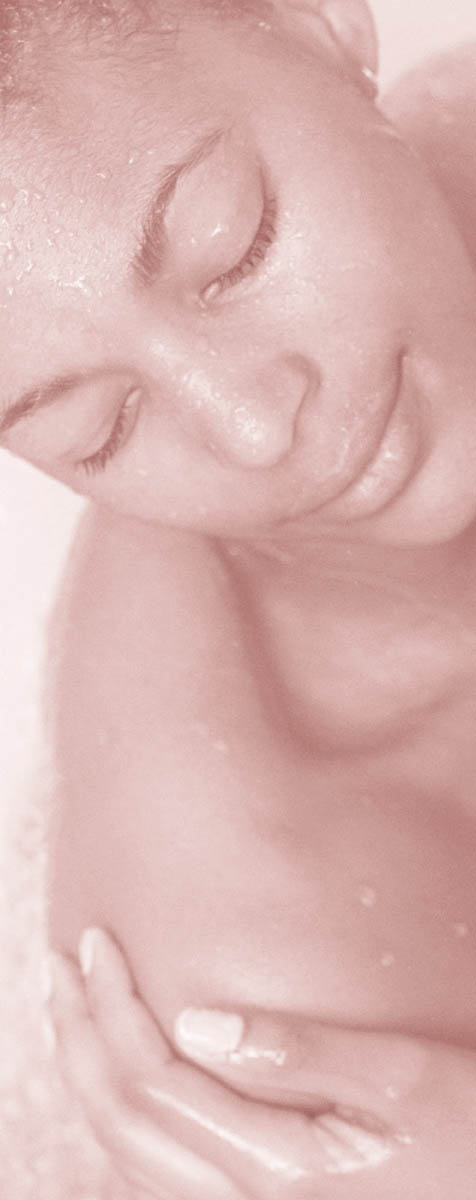

The skin is the largest organ of the body, weighing between 7 and 9 pounds and covering an area of about 20 square feet. The skin is one of the body’s most important workhorses, helping regulate body temperature, absorbing environmental elements, secreting wastes, sending tactile messages to the brain, and allowing us to enjoy the all-important sensation of being touched.
The skin is composed of two main top layers, the epidermis and the dermis. The epidermis, the outermost protective layer of skin, is made up of nerve fibers and tiny cells that are shed continuously throughout our lives. The epidermis is covered by a thin layer made up of a combination of oils and natural secretions called the acid mantle; this is the body’s first defense against bacterial invasion. The acid mantle maintains a balance between acidity and alkalinity, typically described as the pH balance.
In a healthy person between the ages of 15 and 25 years, the cells of the epidermis renew themselves every 20 days. During one’s 30s, the cell-renewal rate slows to about every 28 days. As the natural exfoliation process slows, the skin becomes less active, accumulating more and more dead cells on its surface. These cells are bound together by natural gluelike secretions, forming a sort of thin veil over the skin. It is this veil that causes the skin to lose luster and resilience, appearing duller and less vibrant as we age.
The dermis, located just beneath the epidermis, is sometimes called the “true skin.” The dermis secretes perspiration and sebum, controls hair growth, and covers subcutaneous connective tissue. Sebum, produced by sebaceous glands that are attached to hair cuticles, lubricates the skin’s surface as well as the growing hair. Thus, the sebaceous glands produce a kind of natural moisturizer that keeps skin soft and supple.
A healthy dermis is supple and flexible due to an appropriate amount of elastin and collagen, both of which ensure strength and resilience. The healthier you are, the healthier your skin will be, and it is never too late to incorporate new healthy habits into your lifestyle. Optimum health requires adequate rest; avoidance of sun exposure; regular exercise; lots of fruits, vegetables, and fresh drinking water; and a consistent skin-care regimen utilizing hydrosols, essential oils, and fixed oils chosen to correspond to your skin type.
Before embarking on a skin-care program, it is important to know your skin types. That is not a typo; types is meant to be plural, since most people have at least two distinct facial skin types. In addition, facial skin is always different from skin that covers the rest of the body and must be treated individually for maximum results. Just because you have oily skin most of the time does not mean that your skin cannot become dry, all over or in patches, by virtue of lifestyle changes, such as increased sun exposure, use of chlorinated swimming pools, and extensive airplane travel.
An important caution: As you observe your skin, pay close attention to any unusual bumps, moles, and changes in pigmentation or structure. These irregularities could indicate problems that need medical attention. If you find any unusual-looking or painful spots on your skin, do not hesitate to consult your health-care provider.
If you’d like in-depth information about the skin and how to assess skin types, I recommend Natural Skin Care: Alternative and Traditional Techniques, by Joni Loughran. For our purposes here, a brief description of prevalent skin types will suffice.

Dry skin is caused by under- or inactive oil glands that do not produce enough sebum to keep the skin naturally lubricated. It is therefore characterized by a dull appearance and is often further sullied by flakes and scales. Dry skin feels itchy and taut and is often sensitive. It is important to hydrate dry skin regularly from the inside (with fresh water) and outside (with hydrosols), as well as to moisturize and protect the skin with rich oils that restore luster and pliability. Dry skin benefits from rich formulas containing a balanced combination of oil and water to soothe and hydrate.
People with oily skin have glands that produce excess oil, resulting in a greasy, slippery texture that is frequently accompanied by large, clogged pores. Oily skin types are prone to develop acne, a condition resulting from sebum trapped inside the skin and causing the familiar pus-filled lesions known as comedones. Oily skin and acne are both quite common in teenagers, since the onset of puberty is accompanied by rising hormone levels, which increase the activity of oil glands. Despite these drawbacks, oily skin generally remains younger looking and more supple over time than other skin types. Oily skin benefits from periodic aromatic steam treatments and clay masks.
Sensitive skin can be dry, normal, or oily and is characterized by delicacy. Because it frequently reacts adversely to environmental conditions, it often requires special treatment in order to remain in good condition. This skin type is more prone to react adversely to cosmetics containing alcohol, synthetically manufactured fixed-oil-type ingredients, fragrance oils, and artificial colors. Sensitive skin benefits greatly from natural, gentle, handmade skin-care products and treatments, including light steaming with essential oils.
In normal skin, the oil glands produce sebum at a moderate rate, resulting in a balanced state — not too oily and not too dry. Normal skin looks consistently plump, moist, and vibrant. It is a wonderful blessing but requires no less attention than other skin types. It benefits from regular cleansing, toning, and moisturizing using handmade skin-care products.

Most people have at least two different types of facial skin at any given time. This combination of skin is frequently characterized by an oily “T-zone” — covering the forehead, nose, and chin — while the skin around the cheeks, eyes, and mouth is normal or dry. These different types of skin call for different treatments, so people with combination skin should assess their skin regularly and use different products on different areas of the face.
Your face is the first part of your body that is viewed by the outside world. Whether you are meeting strangers or longtime friends, your face allows people to observe your general state of health.
Most skin-care experts recommend performing three steps, once or twice daily, to maintain healthy, glowing skin. These steps may seem burdensome at first, especially if you have not previously established a skin-care routine of any kind. If you begin to follow them loosely, however, you will soon notice significant changes in your appearance that will encourage you to make them as routine as brushing your teeth. As time passes, you will establish your individual skin-care prescription, which will optimize your skin’s natural strengths and minimize its weaknesses.

Cleansing removes makeup, dirt, and grease from the surface of the skin and is necessary for all skin types. A cleanser can be anything from a mild soap, gentle exfoliant, or hydrosol rinse to a rich cleansing cream or foaming cleanser. Whichever type you choose, apply it to the skin with the pads of the fingers, using small circular motions; gently spread the cleanser over the surface of the skin. You can use a facial brush, cloth, or sponge to apply cleansers, but, in my experience, using the hands provides much more control over the pressure put on the skin. These items can also unnecessarily tug at the skin. When ready, rinse well with warm water, and repeat if necessary. Pat excess moisture from the face and neck.
For gentle cleansers incorporating fresh-food ingredients, try the formulas in Aromatic Beauty Food (chapter 7). Be careful not to over-cleanse your skin, and be sure to alter the number of times per day you cleanse your face depending on how your skin feels. Because my skin is especially dry in the winter, I cleanse once a day in that season, using hydrosols or a combination of fresh-food ingredients. If I wear makeup during the day, I may use a gentle handmade soap or cream cleanser at night. My routine is very different during the dog days of summer, when I usually wash my face at least twice daily.
After cleansing the skin, apply a toner, a product designed to remove leftover makeup or oil residues and to tone and prepare the skin for a moisturizer. An effective toner will leave your clean skin feeling dewy-fresh, enabling it to better absorb the moisturizer that will follow. Select a toner that corresponds to the way your skin feels, and never use toners containing alcohol; these can cause skin to become dry and irritated. Aromatic hydrosols (see opposite for more information) make wonderful facial toners on their own.
The final basic step is to moisturize the skin. Use a product containing fixed oils, hydrosols, and perhaps properly diluted essential oils to prevent moisture loss and give your skin a youthful, glowing, healthful appearance. Choose a moisturizer that suits your skin type and has as many natural ingredients — and as few synthetic ingredients — as possible.
Application of a light moisturizer in the morning, with perhaps a sun protection factor (SPF) if you will be in the sun, will provide moisture as well as protection for your skin. At night, employ a light or rich cream — whatever suits your skin type best — to give yourself a relaxing face, neck, and decolletage massage. Your nighttime moisturizer should be capable of repairing and nourishing your skin as you sleep. Be careful not to apply an excessive amount of moisturizer at night; the skin benefits from unencumbered breathing during sleep. If your skin feels very greasy when you wake up, you probably applied too much moisturizer the night before.
|
Hydrosol |
General Applications |
|
Cornflower (Centaurea cyanus) |
Baby, delicate skin |
|
Cypress (Cupressus sempervirens) |
Oily skin |
|
Helichrysum (Helichrysum italicum) |
Anti-inflammatory uses, eczema |
|
Melissa (Melissa officinalis) |
Anti-inflammatory uses, all skin types |
|
Neroli (Citrus aurantium) |
Baby/delicate and mature skin |
|
Roman chamomile (Chamaemelum nobile) |
Baby/delicate skin, anti-inflammatory uses |
|
Rose (Rosa spp.) |
Balancing properties, dry skin |
|
Rose geranium (Pelargonium graveolens) |
Anti-inflammatory uses |
|
Rosemary (Rosmarinus officinalis), verbenone type |
Oily skin, balancing properties |
|
Sandalwood (Santalum album) |
Skin-cell preserver, stressed-skin soother |
|
Witch hazel (Hamamelis virginiana)* |
Antioxidant, anti-inflammatory uses, oily skin |
|
Yarrow (Achillea millefolium) |
Anti-inflammatory uses, calming and balancing properties |
|
Ylang ylang (Cananga odorata var. genuina) |
Oily skin |
This product can be used on any skin type.
Combine all ingredients in a small bowl and mix well. Massage evenly and gently over face and neck, using upward, sweeping motions. Rinse well and follow with toner and moisturizer. Any leftover product can be stored in the refrigerator for a day or two, but I prefer to make this cleanser fresh each time.

makes approximately 8 ounces (227 g)
Choose any of the seven Aromatic Alchemy blends, starting here, to customize the Truth Serum Facial-Toning Fluid for your skin type. I recommend using no more than 20 drops of an Aromatic Alchemy blend for every 4 ounces of toner. Shake well before each use to incorporate the aromatic oils. This recipe can also be used as the water portion of handmade creams and lotions.
In a clean bottle, combine all ingredients in the order shown. Shake well to incorporate. Apply gently to clean face and neck using a clean cotton pad; you can also rub a small amount of toner between clean palms and then gently pat it onto the skin. Store in the refrigerator, capped tightly, between uses.
This simple oil can be used in any product designed to treat dry, itchy, and inflamed skin. I make about a pound of the oil in the fall and keep it in the freezer for use in handmade skin-care products throughout the winter. You can also use violet (Viola spp.) or calendula (Calendula officinalis) in this formula.
In addition to daily cleansing, toning, and moisturizing, four steps performed less frequently will help keep your skin looking radiant and healthy.
Once a week or so, use a gentle combination of natural ingredients to exfoliate, or slough off, dead skin cells. I sometimes combine a handmade cleanser with an exfoliant to kill two birds with one stone. Avoid using harsh scrubs containing abrasive, hard materials. Instead, try No Excuses Morning Cleanser or some of the formulas in chapter 7 to make gentle scrubs from finely powdered oats and almonds, milk, fresh fruits, and herbal infusions.
Two or three times a month, after you cleanse and/or gently exfoliate, treat your skin to a steam bath to deep-cleanse the pores and stimulate circulation. People with oily skin can steam more regularly than people with dry skin.
To create a facial steam, add 2 drops of an Aromatic Alchemy blend (see here) or an essential oil that suits your skin type to a quart-size bowl of steaming hot water. Seat yourself comfortably at a table with the bowl of water in front of you. Being careful not to touch the bowl, lean over it with your face about 10 inches above the water. Make a tent with a towel, allowing the steam to caress your face and neck area. Enjoy the relaxing steam treatment for about 10 minutes, and follow with a facial mask or toner and moisturizer.
A few times a month, treat yourself to a face and neck mask to balance and invigorate the skin and stimulate circulation. Chapter 7 contains recipes for several beauty masks made with clays, essential oils, fruits juices, and other “freshies” to soothe, nourish, and beautify the skin.
Before using a mask, pull back your hair from your face and cover any exposed clothing. Apply a smooth layer of the mask to freshly cleaned and damp face and neck skin, avoiding the mouth and eye areas. Rest for about 10 minutes while the mask dries; during this time, the product is absorbing excess dirt and oils. Rinse well with warm water, and pat — don’t rub — skin dry. Follow this up with a good moisturizer.
Hydration of the skin from the inside out is paramount, so be sure to drink lots of fresh water daily. In addition, periodic misting of the skin throughout the day is helpful to replenish moisture and is particularly useful if you work in an office environment where the air is stale. I always have a mister bottle of rose hydrosol (or a combination of rose, lavender, and melissa hydrosols) with me to hydrate my face and enjoy an anytime pick-me-up, especially in the afternoon if my energy level begins to decline. To apply, hold the mister bottle about 6 inches from your face; spritz once or twice. You can even use a spray mist if you’re wearing makeup — but allow your face to dry for a few seconds before you touch the skin.

makes 1 application
No Excuses Morning Cleanser is an exfoliator that leaves your skin soft and clean. Grind the oats and almonds ahead of time so you have no excuse not to enjoy this simple pleasure at least once a week.
Combine all ingredients. Mix well and massage over face and neck, using gentle circular movements. Massage your fingers, hands, and forearms with leftover cleanser. Rinse well and follow with toner and moisturizer.
makes 1 application
“Red bush” is the English translation of rooibos, the Afrikaans name for a native South African shrub whose leaves soothe dry, itchy skin. Because of this soothing quality, the smooth facial mask has become one of my wintertime favorites.

There were blazing colors,
There were lovely smells.
I encountered passions my poetry can’t tell.
Mere religion hadn’t changed me yet;
my reverence was all real.
I remember church in the field.
— Phill McHugh, “Church in the Field”
I happened upon Vicki in 1995 as I drove around Cape Cod in search of a local pharmacy. My aromatic radar spotted the words essential and aromatherapy artfully inscribed on a colorful sign on the side of the road. My intention to purchase toothpaste was left by the wayside as I turned off the road in the direction of Vicki’s lovely little store. Several dollars later, I left refreshed and inspired.
Vicki’s love of herbs and essential oils began with a search for natural ways to counteract her own lack of health and well-being. After studying up on herbs and natural healing, Vicki quickly found herself immersed in the creative process, making everything from simple herbal salves to complex blends of essential oils and plant waters. She naturally wanted to share her passion with loved ones, so she began designing formulas for friends and family members.
After selling her preparations at craft fairs, Vicki opened Essential Restoratives, and her product line now encompasses more than 130 formulas. Says Vicki, “The love that goes into my work is as important as the ingredients. I encourage clients to listen to what the body needs and treat it with love.”
My favorite Essential Restoratives product is Fine Lines Facial Cream.